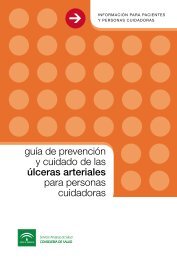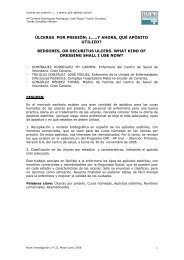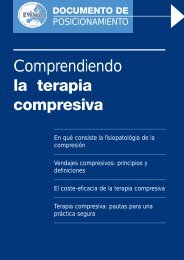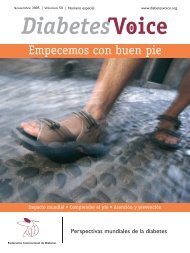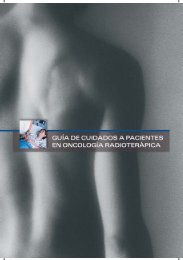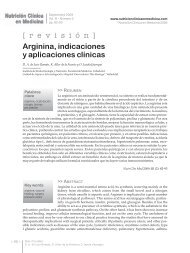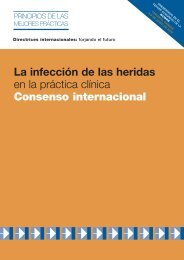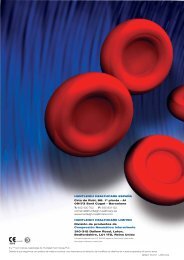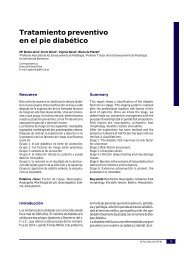Descargar - Úlceras.net
Descargar - Úlceras.net
Descargar - Úlceras.net
- No tags were found...
You also want an ePaper? Increase the reach of your titles
YUMPU automatically turns print PDFs into web optimized ePapers that Google loves.
THE ROLE OF HYPERBARIC OXYGEN THERAPY IN THE TREATMENT OF DIABETIC FOOT ULCERS ■ 127– Synergic effects with antibiotics-The beneficialeffect of HBOT on neovascularization ofthe wounds, increasing tissue perfusion,leads to a larger local bioavailability ofantibiotics, prolonging their action and reinforcingtheir antimicrobial power (28).Direct antimicrobial effects– Bactericidal effect-Hyperoxia leads toincreased endobacterial oxygen radicalswhich in turn lead to abnormal protein synthesisand enzyme-chain inactivation, consequentlycausing bacterial membrane structuredisrupture. This process is more evidentin anaerobic microorganisms, such asClostridium, because of lack of anti-oxidativesystems to defend them from oxygen radical-inducedstress. Even before exerting thisbactericidal effect, HBOT already inhibits theproduction of toxins by those bacteria.HBOT also promotes aerobic bacteria lysisby supersaturating the existent anti-oxidativesystems with oxygen radicals, whichends in their neutralization (18, 24-29).– Bacteriostatic effect-HBOT leads to a nicotinamideadenine dinucleotide phosphateoxidase(NADPH) depletion, with consequentreduction of protein and nucleic acidsynthesis. This process is responsible insu -fficient bacterial supplies of adenosi<strong>net</strong>riphosphate resulting in lower bacterialproliferation (18, 24-29).EVIDENCED-BASED BENEFICIALEFFECTS OF HYPERBARIC OXYGENIN DIABETIC FOOT ULCERSImpact on ulcer healing and wound sizereduction – Most of the available studies whichincluded patients with nonhealing ulcers supporta favorable effect on the account ofHBOT (table IV). Although supported bymore recently published randomized studies,higher rates of wound reduction and healingrates (table IV) are found in non-randomizedstudies.Abidia et al (27) published the first doubleblinded,randomized controlled trial in 2003,with healing rates in the HBOT group of 63%compared to 28% in the control group at 6months of follow-up.Recently, Löndahl et al (30) in an also double-blinded,randomized controlled trialreported healing rates of 52% and 29%(P=.03) after a 1-year period in the HBOTand control group respectively. In this report,patients had undergone a thorough vascularassessment and were found to be poor candidatesfor revascularization. Limitations havebeen stressed, in particular, only 56% of eligiblecandidates were enrolled and only 57% ofthese completed the scheduled treatmentsessions (40), although 80% reached the 35 thsession. One may speculate upon what resultswould had been obtained, had more patientscompleted the scheduled program.Impact on long-term ulcer healing – A sustainedbeneficial effect has been consistentlydetailed in many reports, up until 3 years (30-34). Albuquerque e Sousa (34) published in2005 a retrospective study that included 96patients with diabetic foot ulcers. Amongexcluded patients were all patients whohealed their diabetic foot lesions during theprogrammed HBOT. Follow-up was continuedfor a median period of 45 months for theexperimental group (patients who had beentreated with HBOT but without full cicatrizationof their foot lesions) and of 55 monthsfor the control group. The author found that41.2% of HBOT patients healed their woundin comparison to 3.1% in the control group,difference that proved statistically significant(confidence interval of 95%). A metanalysis onthe behalf of The Cochrane Collaboration(35) was published in 2004, and concludedthat HBOT significantly reduced the risk ofmajor amputation and may improve thechance of healing, thus supporting applicationof this treatment in patients with diabetic footulcers.Impact on amputation rates – Amputationsare the last resource in the management ofdiabetic foot complications and althoughregarded as failure of the treatment of diabe -tic foot, 12% of all diabetic foot ulcers willprogress to amputation (36). Data published





